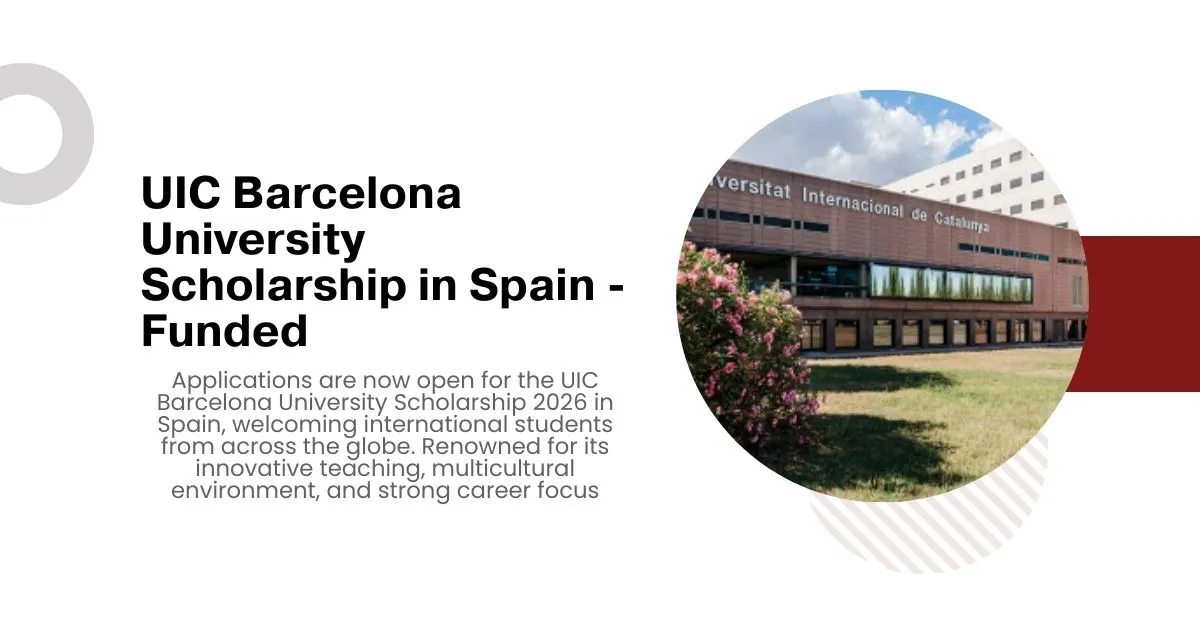
Scholarships for College Students in USA – Fully Funded
The Scholarships for College Students in the United States 2026 application is now open. These possibilities are open to all US citizens, permanent residents, and international students. For undergraduate, graduate, and doctoral studies, there are numerous fully and partially funded scholarships available for the 2026–2027 academic year.
Students will be able to pay for tuition, housing, and other educational costs with the aid of these scholarships. In addition to specialty scholarships for sports, minority students, and those pursuing certain disciplines like STEM, the arts, or teaching, there are merit-based and need-based grants available.
Although it can be expensive, many people dream of studying in the United States. With the help of scholarships, students may concentrate on their studies without having to worry about taking on excessive debt. Numerous programs also provide extra advantages like networking opportunities, leadership development, and mentoring.
Details of Scholarships for College Students in USA
| University: | US Colleges, Universities |
| Degree level: | Bachelors, Masters, PhD |
| Scholarship coverage: | Fully Funded |
| Eligible nationality: | US Citizens, International |
| Award country: | United States |
| Last Date: | Varies |
Read Also: University of Mary Washington Scholarships in USA – Funded
Financial Benefits
The most extensive scholarships are fully funded ones, which are intended to pay for all or a sizable amount of a student’s costs. These can originate from government initiatives, private foundations, or particular colleges and are frequently very competitive.
- Complete Tuition Fee: This is a core component, covering the entire cost of academic instruction.
- Room and Board: The scholarship may cover the cost of on-campus housing and meal plans.
- Stipend: A monthly or yearly stipend is often provided to cover living expenses like food, personal items, and transportation.
- Academic Materials Allowance: This can include funds for textbooks, required software, and other course-related materials.
- Travel Costs: Some scholarships for international students may also include a travel allowance to cover airfare to and from their home country.
- Health Insurance: Health insurance coverage is a critical benefit that is often included in fully funded scholarships.
Partially Funded Scholarships
Partially funded scholarships offer financial assistance that helps reduce the overall cost of attending college but doesn’t cover everything. These are more common than fully funded scholarships and can be a great way to make higher education more affordable.
- Partial Tuition Costs: This is the most common form of partial funding, where a set amount or percentage of the tuition is covered.
- Book Allowances: Some awards are specifically for purchasing textbooks and other academic supplies.
- One-time Academic Grants: These are typically single-payment awards that can be used for any educational expense, such as a laptop, research supplies, or a specific course fee.
- Merit-based Awards: Many universities offer merit-based scholarships that can significantly reduce tuition based on academic achievement, extracurricular activities, or a special talent.
List of Available Scholarship Types:
- Merit-Based Scholarships—For high academic achievers.
- Need-Based Scholarships—For students with financial need.
- Athletic Scholarships—For exceptional sports performance.
- Field-Specific Scholarships—For majors like STEM, nursing, or business.
- Minority Scholarships—For underrepresented groups, including African American, Hispanic/Latino, Native American, Asian American, and LGBTQ+ students.
- Special Talent Scholarships—For students with unique skills in arts, leadership, or community service.
About Scholarships for US College Students
- US schools and Universities: To entice gifted candidates, a number of schools and universities provide their own scholarships. These may be determined by a particular talent, athletic prowess, or intellectual distinction. For instance, several universities provide substantial scholarship packages to exceptional students in order to pay for their entire tuition.
- Federal and State Governments: A range of grants and scholarships are offered by the federal and state governments. The Pell Grant, given to undergraduate students who exhibit extraordinary financial need, is the most well-known federal program. Additionally, states offer their own initiatives to support citizens enrolled in in-state universities.
- Private Foundations: A significant portion of scholarship financing comes from non-profits and private foundations. For example, high-achieving students with financial need can get scholarships from the Jack Kent Cooke Foundation worth up to $55,000 annually.
- Professional Associations: Students pursuing degrees in a particular discipline can apply for scholarships from a number of professional organizations. For instance, an association of engineers may offer a scholarship to an engineering major, supporting the development of the future generation of professionals.
- Local Community Organization typically receive fewer applications, which increases a student’s chances of winning; they are frequently a great source of scholarships. Scholarships are frequently given by alumni associations, local businesses, and community foundations to local students who have shown a dedication to community service, leadership, or academic distinction.
Eligibility Criteria
To be considered for most scholarships, applicants typically must meet the following baseline requirements:
- Enrollment Status: You must be a new or enrolled student at a U.S. college or institution that has earned accreditation. Both undergraduate and graduate students are included in this. Additionally, some scholarships could be offered for programs at trade or technical schools.
- Academic Standing: You must fulfill certain academic requirements for the majority of scholarships. For merit-based scholarships, this might be a minimal GPA; for field-specific grants, it could be a proven dedication to a certain field of study. To retain a scholarship, continuing students frequently need to demonstrate “Satisfactory Academic Progress” (SAP).
- Citizenship and Residency: You must be a U.S. citizen or an eligible non-citizen (such as a permanent resident with a green card) in order to be eligible for many scholarships, especially those that are sponsored by the federal or state governments. Nonetheless, more and more scholarships are available to DACA beneficiaries, international students, and students from mixed-status households.
- Financial Need: Proving financial need is a crucial prerequisite for need-based scholarships. Usually, to accomplish this, one must fill out the Free Application for Federal Student Aid (FAFSA). A student’s financial need is determined by the FAFSA by taking into account their family’s assets, income, and other variables.
- Specific Criteria: For specialized scholarships, you must meet the specific requirements of the award. This could include:
- Field of Study: Being enrolled in a specific major like STEM, nursing, or business.
- Demographic Group: Identifying with an underrepresented group, such as being a member of a specific racial, ethnic, or LGBTQ+ community.
- Talent: Demonstrating exceptional skills in arts, athletics, or leadership.
Ineligibility Criteria
Knowing what disqualifies an application is equally crucial. Scholarships have strict requirements, and you risk being disqualified if you don’t meet any of them.
- Citizenship or Residency: If you are an international student without the necessary status and a scholarship is only available to U.S. citizens, you will not be eligible.
- Ineligible Program or Institution: Certain scholarships are associated with particular programs or colleges. You will not be eligible if you are not enrolled in one of these programs or schools. For instance, a student at a private institution would not be eligible for a scholarship intended for students at a state university.
- Missed Deadlines: Applications for scholarships must be submitted on time. In most cases, missing an application deadline—even by one day—makes you ineligible.
- Incomplete or Incorrect Documentation: You will be disqualified if you provide false information or don’t submit all the necessary paperwork (such as essays, reference letters, and transcripts).
- Academic Probation: You may no longer be eligible for financial aid and scholarships if you are a returning student on academic probation or if your school determines that you are not making adequate academic progress.
How to Apply
Applying for scholarships is a crucial step for many students seeking to finance their education. The process, while sometimes demanding, can be broken down into a series of manageable steps.
1. Search and Select Scholarships
The first step is to find scholarships that you are eligible for. The key is to cast a wide net while also focusing on awards that match your specific qualifications.
- Online Scholarship Search Platforms: Utilize free online databases and search tools. Websites like Fastweb and others allow you to create a profile and get personalized scholarship recommendations based on your academic record, interests, and other factors.
- School and University Resources: Check with the financial aid office at your current or prospective school. Many institutions have their own scholarships for students, and they can also provide a list of other external scholarships.
- Local Organizations: Don’t overlook local opportunities. Community organizations, religious groups, and local businesses often offer scholarships to students from the area, and these may have less competition.
- Professional Associations: If you have a specific major in mind, look for professional associations in that field. Many offer scholarships to help students with their studies.
2. Prepare Required Documents
Gathering all the necessary documents in advance will streamline the application process. Create a dedicated folder to keep everything organized.
- Academic Transcripts: You will likely need official or unofficial transcripts from your high school or current college.
- Free Application for Federal Student Aid (FAFSA): If you are applying for need-based scholarships, you will need to complete the FAFSA. This form determines your eligibility for federal student aid, and many colleges and private organizations use it to determine financial need.
- Letters of Recommendation: Ask teachers, professors, or employers who know you well to write a letter of recommendation. Provide them with ample time (at least 3-4 weeks) and give them information about the scholarship and why you are applying.
- Personal Essays: Many scholarships require a personal essay or statement. This is your chance to stand out. Be authentic and reflective, and use specific examples to showcase your character, goals, and why you are a deserving candidate. Tailor each essay to the specific prompt and scholarship.
- Resume/CV: Create a resume that highlights your academic achievements, extracurricular activities, volunteer work, and any leadership roles you have held.
3. Submit Applications
Once you have all your materials, carefully follow the submission instructions for each scholarship.
- Read Instructions Carefully:Pay close attention to all the details in the application. This includes formatting requirements for essays, how to submit letters of recommendation, and which documents need to be official.
- Proofread Everything: Before submitting, proofread your application, essay, and all other documents for any spelling or grammatical errors. It is also a good idea to have a friend, family member, or teacher review your materials for clarity and accuracy.
Conclusion
For many students who want to study in the US, obtaining a scholarship is an essential first step. For the 2026–2027 academic year, there are numerous completely and partially funded scholarship options available, providing chances for students with different requirements and backgrounds. A proactive and well-planned strategy is essential for success, and this includes investigating suitable scholarships, carefully preparing all necessary paperwork, and sending applications well in advance of the due dates. Students can obtain the financial help they need to concentrate on their academic and personal development without having to worry about taking on too much debt by utilizing the resources offered by institutions, private foundations, and professional associations.
Frequently Asked Questions
What documents are needed to apply for a scholarship?
Commonly required documents include academic transcripts, letters of recommendation, a personal essay, a resume, and the Free Application for Federal Student Aid (FAFSA) for need-based awards. You should always confirm the specific requirements for each scholarship.
Who is eligible to apply for these scholarships?
These scholarships are available to a wide range of students, including U.S. citizens, permanent residents, and international students. Specific eligibility criteria can vary, often including requirements for academic standing, financial need, and sometimes a specific field of study or demographic group.



